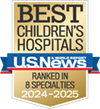
Over the Counter Medications Safety Guide
Posted: October 21, 2010It's National Hospital and Health System Pharmacy week. Le Bonheur Children's Hospital would like to share with parents some excellent information on over-the-counter drug safety. We got the following information from OTCsafety.org, the web site of the Consumer Healthcare Products Association (CHPA) Educational Foundation, which has up-to-date information to help families understand the safe and appropriate use of over-the-counter medicines.
Do you know which medicines to give your child, when to use them and how to use them safely?
Important tips to remember when giving your child oral OTC cough and cold medicines:
- Always read and follow medicine labels exactly and use the measuring device that comes with the medicine.
- Do not give a medicine only intended for adults to your child.
- Only give the medicine that treats your child's specific symptoms.
- Never give two medicines at the same time that contain the same active ingredient.
- Do not use oral cough and cold medicines for children under age four.
- Never use an OTC medicine to sedate or make your child sleepy.
- Never give aspirin-containing products to your child for cold or flu symptoms unless told to do so by a doctor.
- If your child develops any side effects or reactions that concern you, stop giving the OTC medicine and contact a doctor immediately.
- Keep all medicines out of your child's reach and sight.
- Talk to a doctor, pharmacist or other healthcare provider if you have any questions.
How to read a drug facts label
Active Ingredient:
This section lists the ingredient or ingredients that make the medicine work. It is very important to pay attention to this section if you are taking more than one medicine - whether OTC or prescription - to make sure you are not taking too much of the same active ingredient.
Purpose:
This section tells you what type, or category, or medicine it is, such as a cough suppressant or nasal decongestant.
Uses:
This section tells you what symptoms or illnesses you can expect the medicine to treat. You should only use products that treat your child's symptoms.
Warnings:
There are times when you should not take a particular medicine. The warnings section explains these times, and also tells you when to talk to a doctor or other healthcare professional, as well as when to stop taking a medicine. This section also reminds parents and other caregivers to keep medicine out of the reach of children and to never use these medicines to sedate or make your child sleepy.
Directions:
This section tells you exactly how and when to take a medicine. Always read and follow the directions exactly and use the measuring or dosing device that comes with liquid medications. Do not use children's oral cough and cold medicines in children under age 4 and never give more than the label says. If you have any questions talk to your child's doctor before giving a medicine to your child.
Other Information:
This section tells you other important information you should know about a medicine, such as where to store it. You should always keep medications out of the reach and sight of children.
Inactive Ingredients:
The inactive ingredients list other ingredients in the medicine such as colors and flavoring and are important especially if your child has a known allergy.
Special attention should always be used when giving children any medicine. Remember, OTC medicines like all medicines are serious medications and need to be used carefully. Below are some more helpful tips when using OTC medications on your child.
Follow the Dosing Directions on the Label
You should never guess about dosing amounts - especially when giving medicines to children. Every medicine has dosing directions on its label, and those directions - including the amount of medicine to give, when to give it and when not to give it - should be followed exactly. If the medicine does not include a dose for your child's age or specifically says DO NOT USE, do not give that medicine to your child. Instead, call your doctor for advice about the best treatment options for your child.
Use the Right Dosing Device
The Drug Facts label will state the correct dose of medicine. Dosing instructions found on the label are not recommendations but specific instructions about the exact amount that you should use to treat your child's symptoms. It is important to always follow the dosing directions on the Drug Facts label and, for liquid medicines, to use the dosing or measuring device that comes with the medicines. Do not use common kitchen spoons to measure as they are not meant for measuring medicines.
Pay Attention to Active Ingredients
To avoid giving too much of the same medicine, you should always pay close attention to the active ingredient, especially if you need to give your child more than one medication at a time. Many medications - both prescription and OTC - can contain the same active ingredients. Giving two medicines with the same active ingredients may cause harm if a child is given too much of a particular medicine. Always double check the active ingredient, and if you are confused or have questions, make sure to speak to a doctor or healthcare professional before giving the medicine to your child.
Never Use OTC Medicines to Make a Child Sleepy
Like all medicines, OTC medicines are real medicines that should be taken seriously and only used to treat a child's symptoms. OTC medications should never be used with the intention of sedating your child or making your child sleepy and can cause harm if used in this manner. Never give an OTC medicine to make your child sleepy.
The CHPA Educational Foundation is the nonprofit foundation of the Consumer Healthcare Products Association, and is dedicated to providing education to consumers on the appropriate and safe use of over-the-counter medicines and nutritional supplements.



